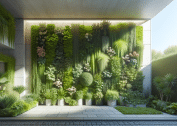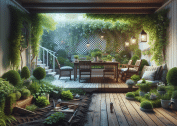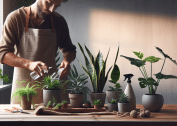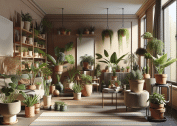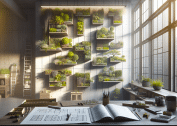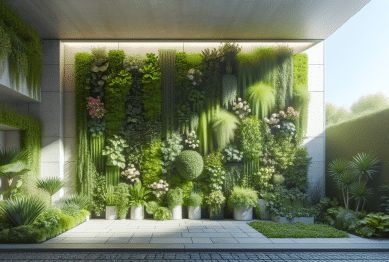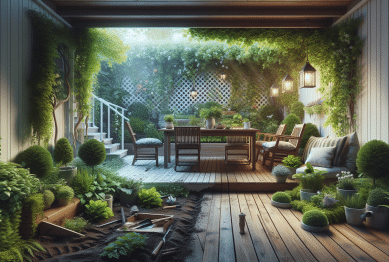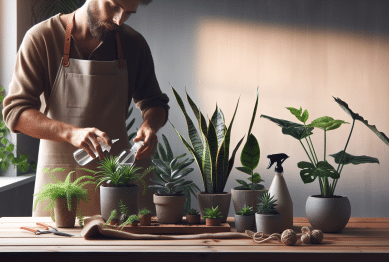Explore how adding indoor plants can elevate your home’s comfort, health, and style. Learn about the best plant choices, care strategies, and benefits that go beyond decor. This guide unlocks fascinating insights for anyone curious about bringing nature indoors.
Enhancing Mood and Well-being with Indoor Greenery
Fostering well-being at home starts with small changes. Bringing indoor plants into your living space can influence mood in striking ways. Greenery serves as a natural stress reliever; it offers a calming visual break from screens and concrete. Studies indicate that interacting with houseplants may reduce anxiety and trigger feelings of happiness. This phenomenon is rooted in ‘biophilia,’ a human tendency to seek connections with nature indoors. When plants are thoughtfully arranged, spaces feel tranquil, balanced, and genuinely inviting, which can make unwinding after a busy day much easier (Source: https://www.ncbi.nlm.nih.gov/pmc/articles/PMC4419447/).
Plants also boost cognitive function. An intriguing aspect of indoor gardening is its impact on attention and memory. Research from environmental psychology suggests that workplaces and homes filled with plants promote greater focus and creativity. Exposure to plants, even passively, has been linked to increased productivity and improved problem-solving. For families, including children, greenery at home may even support cognitive development. The nurturing tasks of watering and observing growth provide a mindful break from daily routines.
Some popular varieties, like snake plants and pothos, require little care but offer significant results. Placement matters as well; the sight of cascading greens by a window lifts spirits and creates a sense of peace. Adding a plant or two to a bedroom or study could make those spaces feel fresher and more comfortable. These subtle shifts in environment support relaxation, lending a renewed sense of well-being to indoor life.
Improving Indoor Air Quality Naturally
Did you know that houseplants can help clean indoor air? Many common household plants naturally filter toxins and improve air quality. Volatile organic compounds (VOCs), released by products like paint and cleaning agents, often linger in enclosed spaces. Studies have shown that certain plants, including peace lilies and spider plants, absorb pollutants through their leaves and roots. This natural purification process, sometimes called ‘phytoremediation,’ helps lower airborne chemicals and creates a healthier environment (Source: https://ntrs.nasa.gov/api/citations/19930073077/downloads/19930073077.pdf).
The benefit goes beyond chemical removal. Through photosynthesis, plants convert carbon dioxide to oxygen, contributing to fresher indoor air. This is particularly noticeable in rooms with poor ventilation. Ferns and bamboo palms are excellent oxygenators and also add a touch of elegance to your interiors. Keeping a mix of large and small plants enhances this effect, as different species target various air toxins while maintaining attractive diversity.
However, not all plants purify air equally. Placement, light, and watering matter. For those looking to maximize benefits, it’s wise to select species suited to your home’s microclimate. Positioning a few air-purifying plants in bedrooms or offices can help promote restful sleep and clearer morning air. Even a modest indoor jungle can make a difference where windows are limited and fresh breezes are rare.
Low-Maintenance Choices for Busy Households
Not everyone has a green thumb, but low-maintenance plants make indoor gardening accessible. Selecting varieties that thrive in varied lighting and can handle occasional neglect simplifies plant care for beginners or hectic households. Succulents, such as jade plants and echeveria, are popular because they require minimal watering and adapt to a range of conditions. Zamioculcas zamiifolia (ZZ plant) and sansevieria are similarly hardy and rarely troubled by pests (Source: https://extension.psu.edu/indoor-plants-for-every-space).
Choosing the right container and soil is equally important for healthy growth. Well-draining pots prevent root rot, while quality potting mix provides essential nutrients. Consider starting with self-watering planters or selecting species native to dry environments if forgetting a weekly watering is a concern. Place these plants somewhere you’ll see them daily, like a kitchen shelf or hallway table, to gently remind yourself of their presence and needs.
Even in apartments with little natural light, robust options exist. Pothos and philodendron tolerate lower light and only need occasional drinks. These versatile greens adapt to both bright corners and shady nooks. For parents, pet owners, or frequent travelers, low-care options deliver the joy of greenery without high commitment. Start with one or two, observe what thrives, and expand with confidence over time.
Elevating Decor with Creative Plant Styling
Indoor plants serve as vibrant decor elements that transform ordinary rooms into statement spaces. Creative styling can change the feel and function of any nook. Consider trailing vines above a bookshelf, a structural monstera as a living sculpture, or clustered succulents for a contemporary vibe. Using decorative pots, stands, and shelves adds depth, color, and texture while supporting plant health. With endless possibilities, your house can reflect your personality—eclectic, minimalist, or bohemian (Source: https://www.rhs.org.uk/advice/profile?PID=906).
Grouping plants of varying heights and leaf shapes draws the eye and makes displays feel purposeful. Mixing tall with trailing varieties—like pairing dracaena with pothos—enhances visual interest while maximizing the impact of limited surfaces. For smaller rooms, wall-mounted planters or hanging baskets save space while transforming vertical surfaces into lush green art. Experimenting with arrangement lets you continuously refresh the atmosphere and adjust to seasonal changes in light.
Many find that nurturing a personal ‘indoor jungle’ elevates their connection to home. Seasonal flowering plants add bursts of color and fragrance. Mixing edible plants, such as herbs, further integrates functionality and style. Arrangement can be playful—rotate pots for balanced sun exposure, or display favorites where they spark joy at a glance. With creativity and care, indoor plants harmonize design and wellness in every corner.
Practical Tips for Thriving Indoor Plants
Consistency is the secret to flourishing indoor gardens. Most plants appreciate even water and light routines. It’s useful to place plants where natural sunlight is abundant and to rotate pots so all sides thrive. Watering should match the plant’s origin—desert types need less, tropicals might want humidity. Overwatering is a common misstep; always feel the soil before adding more water (Source: https://www.gardeningknowhow.com/houseplants/hpgen/houseplant-care.htm).
Understanding plant signals is practical. Drooping leaves, yellowing, or spots can indicate too much or too little water, low humidity, or insufficient nutrients. Regularly cleaning leaves helps photosynthesis and deters pests. Feeding with a balanced fertilizer every few weeks during growing seasons supports lush growth. It’s best to avoid sudden moves—plants need time to adjust to changes in light or location.
Caring for plants can be an enriching, mindful activity. Engaging with the rhythms of watering, pruning, or repotting connects people to the natural world, even in urban settings. There’s no perfect routine; trial and patience reveal each plant’s needs. When combined with attention to air quality and decor, the result is a green, vibrant, and welcoming home environment.
Special Considerations: Pets, Allergies, and Family Safety
While indoor plants offer benefits, choosing species that are safe for children and pets is important. Some houseplants, like philodendron or lilies, may cause mild reactions if nibbled. For pet lovers or households with small children, opt for non-toxic options such as spider plants, areca palms, or Boston ferns. Always place potentially irritating species out of reach or lock them behind barriers. For peace of mind, verify plant safety through trusted sources before adding new varieties (Source: https://www.aspca.org/pet-care/animal-poison-control/toxic-and-non-toxic-plants).
Those with allergies may worry about mold or pollen. Most leafy houseplants are low-pollen and rarely trigger allergies, yet overwatering can cause mold in soil. Using potting mixes with good drainage and letting topsoil dry between waterings helps reduce this risk. Regular cleaning of leaves removes dust that could cause inhalation issues. HEPA filters in rooms with lots of greenery create an even safer sanctuary for sensitive individuals.
Teaching children care routines, such as watering or gentle pruning, supports safe plant interaction. Supervised gardening builds a sense of responsibility and wonder, drawing families together in shared activity. Choosing the right mix of greenery ensures indoor plants enrich everyone’s lives without risk, turning the home into a safe, lush oasis.
References
1. Bringslimark, T., Hartig, T., & Patil, G. G. (2009). The psychological benefits of indoor plants: A critical review of the experimental literature. Retrieved from https://www.ncbi.nlm.nih.gov/pmc/articles/PMC4419447/
2. Wolverton, B. C., Douglas, W. L., & Bounds, K. (1989). A study of interior landscape plants for indoor air pollution abatement. NASA Report. Retrieved from https://ntrs.nasa.gov/api/citations/19930073077/downloads/19930073077.pdf
3. Penn State Extension. (n.d.). Indoor plants for every space. Retrieved from https://extension.psu.edu/indoor-plants-for-every-space
4. Royal Horticultural Society. (n.d.). Top 10 house plants. Retrieved from https://www.rhs.org.uk/advice/profile?PID=906
5. Gardening Know How. (n.d.). Houseplant care. Retrieved from https://www.gardeningknowhow.com/houseplants/hpgen/houseplant-care.htm
6. American Society for the Prevention of Cruelty to Animals. (n.d.). Toxic and non-toxic plants. Retrieved from https://www.aspca.org/pet-care/animal-poison-control/toxic-and-non-toxic-plants


